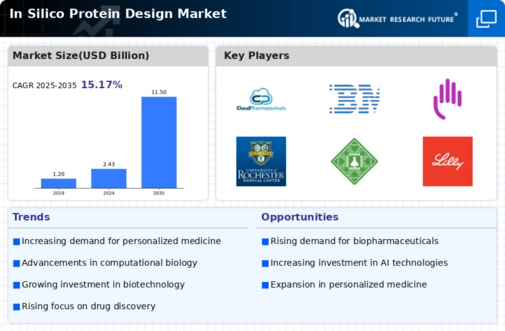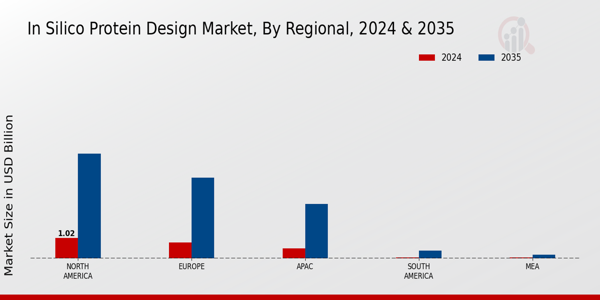Market Growth Projections
Rising Demand for Biopharmaceuticals
The increasing demand for biopharmaceuticals is a primary driver of the Global In Silico Protein Design Market Industry. As the biopharmaceutical sector expands, the need for innovative protein designs to create effective therapeutics becomes paramount. In 2024, the market is projected to reach 2.43 USD Billion, reflecting a growing reliance on computational methods to streamline drug development processes. Companies are leveraging in silico techniques to enhance the efficacy and safety profiles of new drugs, which is crucial in meeting regulatory standards. This trend is expected to continue, contributing significantly to the market's growth as biopharmaceuticals become a cornerstone of modern medicine.
Growing Focus on Personalized Medicine
The shift towards personalized medicine is significantly influencing the Global In Silico Protein Design Market Industry. As healthcare moves towards tailored therapies, the need for customized protein designs that cater to individual patient profiles becomes increasingly important. In silico methods allow for the rapid design and testing of proteins that can be optimized for specific genetic backgrounds, enhancing treatment efficacy. This trend is likely to foster collaboration between computational biologists and clinical researchers, driving innovation in protein design. The market's growth is expected to be robust, with a projected CAGR of 15.18% from 2025 to 2035, reflecting the rising importance of personalized approaches in healthcare.
Advancements in Computational Technologies
Technological advancements in computational methods are propelling the Global In Silico Protein Design Market Industry forward. Innovations in artificial intelligence and machine learning are enabling more accurate predictions of protein structures and functions. These advancements facilitate the design of proteins with desired characteristics, thereby accelerating the drug discovery process. As computational power increases, the ability to simulate complex biological interactions improves, leading to more efficient protein design. This trend is likely to attract investment and research initiatives, further enhancing the market's growth trajectory. By 2035, the market could potentially reach 11.5 USD Billion, driven by these technological breakthroughs.
Regulatory Support for Computational Approaches
Regulatory bodies are increasingly recognizing the value of computational approaches in drug development, which serves as a significant driver for the Global In Silico Protein Design Market Industry. Guidelines that support the use of in silico methods for protein design and evaluation are being established, facilitating their integration into standard practices. This regulatory support not only enhances the credibility of in silico techniques but also encourages their adoption by industry stakeholders. As regulations evolve to accommodate these innovative approaches, the market is expected to benefit from increased acceptance and utilization of in silico protein design methodologies.
Increased Investment in Research and Development
Investment in research and development is a critical driver of the Global In Silico Protein Design Market Industry. As pharmaceutical and biotechnology companies recognize the potential of in silico methods, funding for R&D initiatives is on the rise. This investment supports the development of new algorithms and software tools that enhance protein design capabilities. Furthermore, government grants and initiatives aimed at promoting biotechnological advancements contribute to this trend. The influx of capital is likely to accelerate innovation and improve the efficiency of drug development processes, thereby expanding the market. This trend aligns with the overall growth trajectory of the industry.





















